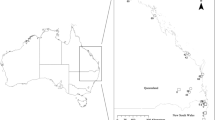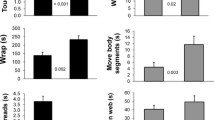Abstract
Intricate predatory strategies are widespread in the salticid subfamily Spartaeinae. The hypothesis we consider here is that the spartaeine species that are proficient at solving prey-capture problems are also proficient at solving novel problems. We used nine species from this subfamily in our experiments. Eight of these species (two Brettus, one Cocalus, three Cyrba, two Portia) are known for specialized invasion of other spiders’ webs and for actively choosing other spiders as preferred prey (‘araneophagy’). Except for Cocalus, these species also use trial and error to derive web-based signals with which they gain dynamic fine control of the resident spider’s behaviour (‘aggressive mimicry’).The ninth species, Paracyrba wanlessi, is not araneophagic and instead specializes at preying on mosquitoes. We presented these nine species with a novel confinement problem that could be solved by trial and error. The test spider began each trial on an island in a tray of water, with an atoll surrounding the island. From the island, the spider could choose between two potential escape tactics (leap or swim), but we decided at random before the trial which tactic would fail and which tactic would achieve partial success. Our findings show that the seven aggressive-mimic species are proficient at solving the confinement problem by repeating ‘correct’ choices and by switching to the alternative tactic after making an ‘incorrect’ choice. However, as predicted, there was no evidence of C. gibbosus or P. wanlessi, the two non-aggressive-mimic species, solving the confinement problem. We discuss these findings in the context of an often-made distinction between domain-specific and domain-general cognition.




Similar content being viewed by others
References
Anselme P (2012) Modularity of mind and the role of incentive motivation in representing novelty. Anim Cogn 15:443–459
Barrett HC, Kurzban R (2006) Modularity in cognition: framing the debate. Psychol Rev 113:628–647
Bednarski JV, Taylor P, Jakob EM (2012) Optical cues used in predation by jumping spiders, Phidippus audax (Araneae, Salticidae). Anim Behav 84:1221–1227
Beecher MD (1988) Some comments on the adaptationist approach to learning. In: Bolles RC, Beecher MD (eds) Evolution and learning. Lawrence Erlbaum Assoc, UK, pp 239–248
Chiappe D, MacDonald K (2005) The evolution of domain-general mechanisms in intelligence and learning. J Gen Psychol 132:5–40
Coltheart M (1999) Modularity and cognition. Trends Cogn Sci 3:115–120
Dennett DC (1996) Kinds of minds: towards an understanding of consciousness. Simon and Schuster, New York
Dukas R (1998) Evolutionary ecology of learning. In: Dukas R (ed) Cognitive ecology: the evolutionary ecology of information processing and decision making. University of Chicago Press, Chicago, pp 129–174
Dukas R (2008) Evolutionary biology of insect learning. Annu Rev Entomol 53:145–160
Fodor JA (1983) The modularity of mind. MIT Press, Cambridge
Harland DP, Jackson RR (2004) Portia perceptions: the Umwelt of an araneophagic jumping spider. In: Prete FR (ed) Complex worlds from simpler nervous systems. MIT Press, Cambridge, pp 5–40
Harland DP, Li D, Jackson RR (2012) How jumping spiders see the world. In: Lazareva O, Shimizu T, Wasserman EA (eds) How animals see the world: comparative behavior, biology, and evolution of vision. Oxford University Press, New York, pp 133–164
Healy SD, Rowe C (2007) A critique of comparative studies of brain size. Proc R Soc B 274:453–464
Jackson RR (1990a) Predatory and nesting behaviour of Cocalus gibbosus, a spartaeine jumping spider (Araneae: Salticidae) from Queensland. N Z J Zool 17:483–490
Jackson RR (1990b) Predatory versatility and intraspecific interactions of Cyrba algerina and Cyrba ocellata, web-invading Spartaeine jumping spiders (Araneae: Salticidae). N Z J Zool 17:157–168
Jackson RR (1992) Eight-legged tricksters: spiders that specialize at catching other spiders. Bioscience 42:590–598
Jackson RR, Blest AD (1982) The biology of Portia fimbriata, a web-building jumping spider (Araneae, Salticidae) from Queensland: utilization of webs and predatory versatility. J Zool 196:255–293
Jackson RR, Carter CM (2001) Geographic variation in reliance on trial-and-error signal derivation by Portia labiata, an araneophagic jumping spider from the Philippines. J Insect Behav 14:799–827
Jackson RR, Cross FR (2011) Spider cognition. Adv Insect Physiol 41:115–174
Jackson RR, Cross FR (2013) A cognitive perspective on aggressive mimicry. J Zool 290:161–171
Jackson RR, Hallas SEA (1986a) Predatory versatility and intraspecific interactions of spartaeine jumping spiders (Araneae: Salticidae): Brettus adonis, B. cingulatus, Cyrba algerina and Phaeacius sp. indet. N Z J Zool 13:491–520
Jackson RR, Hallas SEA (1986b) Comparative biology of Portia africana, P. albimana, P. fimbriata, P. labiata and P. schultzi, araneophagic, web-building jumping spiders (Araneae: Salticidae): utilisation of webs, predatory versatility, and intraspecific interactions. N Z J Zool 13:423–489
Jackson RR, Nelson XJ (2011) Reliance on trial-and-error signal derivation by Portia africana, an araneophagic jumping spider from East Africa. J Ethol 29:301–307
Jackson RR, Pollard SD (1996) Predatory behavior of jumping spiders. Annu Rev Entomol 41:287–308
Jackson RR, Wilcox RS (1993) Spider flexibly chooses aggressive mimicry signals for different prey by trial and error. Behaviour 127:21–36
Jackson RR, Carter CM, Tarsitano MS (2001) Trial-and-error solving of a confinement problem by a jumping spider, Portia fimbriata. Behaviour 138:1215–1234
Jackson RR, Cross FR, Carter CM (2006) Geographic variation in a spider’s ability to solve a confinement problem by trial and error. Int J Comp Psychol 19:282–296
Jackson RR, Li D, Woon JRW, Hashim R, Cross FR (2014) Intricate predatory decisions by a mosquito-specialist spider from Malaysia. R Soc Op Sci 1:140131
Jakob EM, Skow CD, Long S (2011) Plasticity, learning and cognition. In: Herberstein ME (ed) Spider behaviour: flexibility and versatility. Cambridge University Press, Cambridge, pp 307–347
Johnston TD (1982) The selective costs and benefits of learning: an evolutionary analysis. Adv Study Behav 12:65–106
Kuczaj SA II, Walker RT (2012) Dolphin problem solving. In: Zentall TR, Wasserman EA (eds) The Oxford handbook of comparative cognition. Oxford University Press, New York, pp 736–756
Land MF, Nilsson D-E (2012) Animal eyes, 2nd edn. Oxford University Press, Oxford
Liedtke J, Schneider JM (2014) Association and reversal learning abilities in a jumping spider. Behav Proc 103:192–198
Papaj DR (1986) Interpopulation differences in host preferences and the evolution of learning in the butterfly, Battus philenor. Evolution 40:518–530
Platnick NI (2014) The world spider catalogue. http://research.amnh.org/iz/spiders/catalog/SALTICIDAE.html
Reader SM, Laland KN (eds) (2003) Animal innovation. Oxford University Press, New York
Simon H (1969) The sciences of the artificial. MIT Press, Cambridge
Skinner BF (1938) The behavior of organisms. Appleton, New York
Staddon JER (1983) Adaptive behavior and learning. Cambridge University Press, Cambridge
Stephens DW (1991) Change, regularity and value in the evolution of animal learning. Behav Ecol 2:77–89
Stratton GE, Suter RB, Miller PR (2004) Evolution of water surface locomotion by spiders: a comparative approach. Biol J Linn Soc 81:63–78
Su KFY, Meier R, Jackson RR, Harland DP, Li D (2007) Convergent evolution of eye ultrastructure and divergent evolution of vision-mediated predatory behaviour in jumping spiders. J Evol Biol 20:1478–1489
Suter RB (2013) Spider locomotion on the water surface: biomechanics and diversity. J Arachnol 41:93–101
Webb B (2012) Cognition in insects. Philos Trans R Soc B 367:2715–2722
Żabka M, Kovac D (1996) Paracyrba wanlessi—a new genus and species of Spartaeinae from Peninsular Malaysia with notes on its biology (Arachnida: Araneae: Salticidae). Senckenb biol 76:153–161
Acknowledgments
We thank Stephene Abok Aluoch for his assistance at ICIPE. For their helpful comments on an earlier version of the manuscript, we thank two anonymous reviewers. We also gratefully acknowledge support of Grants from the New Zealand Foundation for Research, Science and Technology (UOCX0903), the Royal Society of New Zealand (Marsden Fund (UOC305, UOC0507, UOC1301) and James Cook Fellowship (02/05)), the National Geographic Society (8676-09, 6705-00) and the US National Institutes of Health (R01-AI077722).
Author information
Authors and Affiliations
Corresponding author
Rights and permissions
About this article
Cite this article
Cross, F.R., Jackson, R.R. Solving a novel confinement problem by spartaeine salticids that are predisposed to solve problems in the context of predation. Anim Cogn 18, 509–515 (2015). https://doi.org/10.1007/s10071-014-0819-z
Received:
Revised:
Accepted:
Published:
Issue Date:
DOI: https://doi.org/10.1007/s10071-014-0819-z




